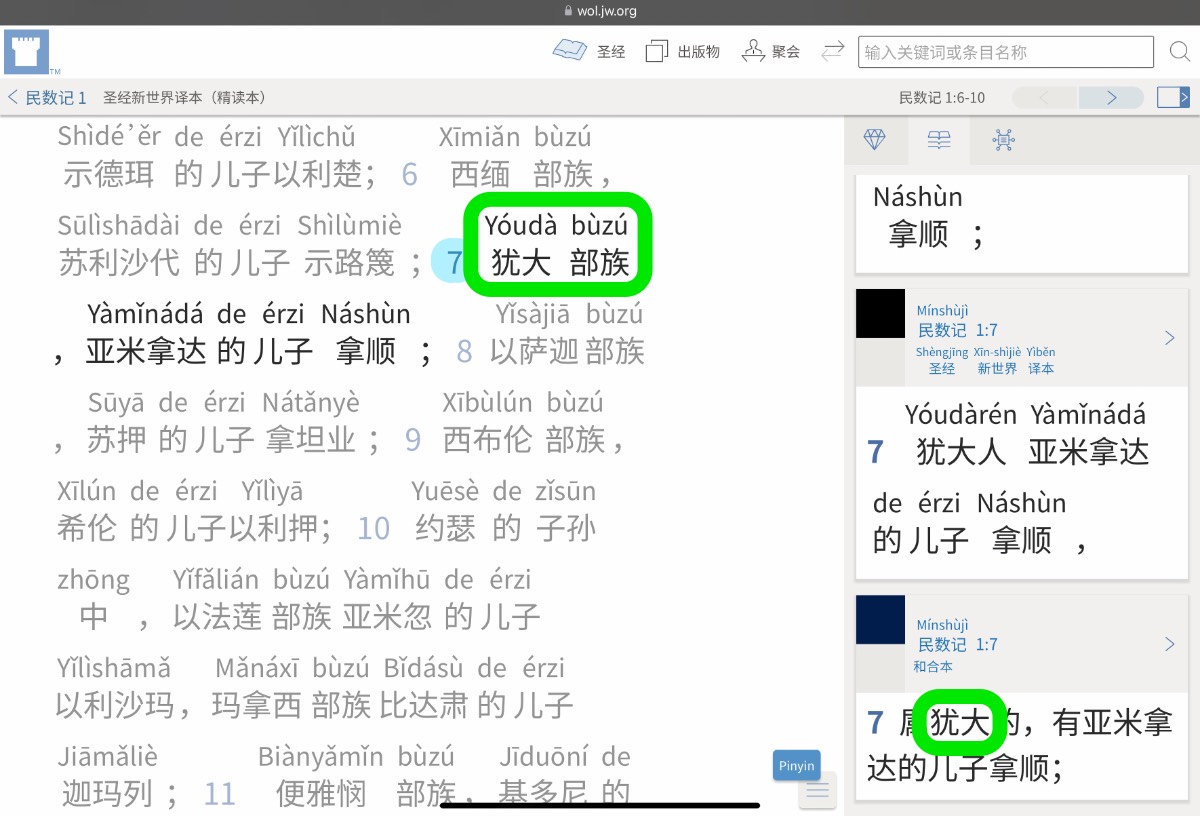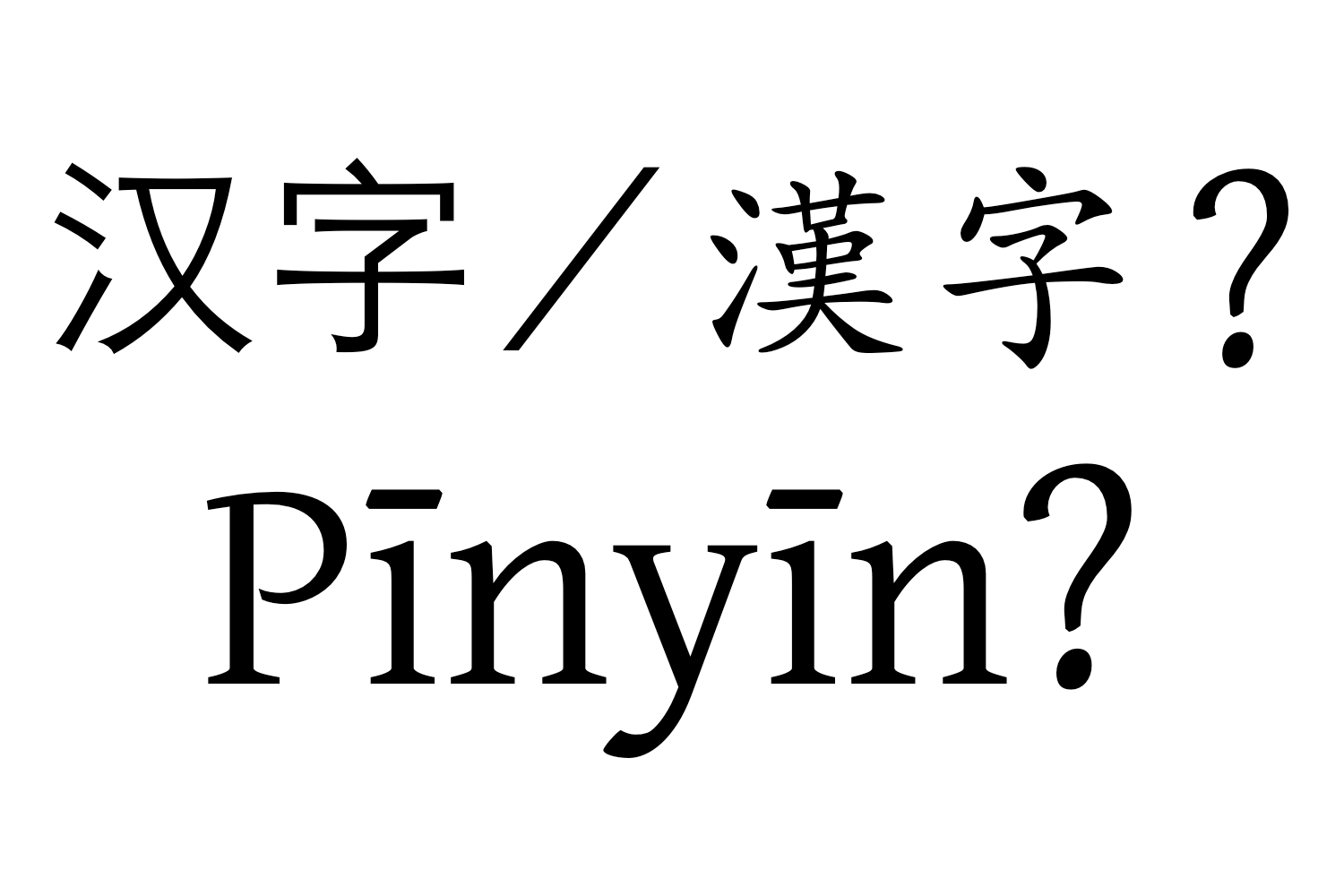rénkǒu
(rén·kǒu
people · {mouths of} → [population; number of people in a family]
人口)
← Tap/click to show/hide the “flashcard”
Lesson 05, point 6 of the
Yǒngyuǎn Xiǎngshòu Měihǎo de Shēngmìng—Hùdòng Shì Shèngjīng Kèchéng
((Yǒng·yuǎn
Eternally · {Far (in Time)}
永远
永遠)
(Xiǎng·shòu
Enjoy · Receive
享受)
(Měi·hǎo
Beautiful · Good
美好)
(de
’s
的)
(Shēngmìng
Life
生命)—(Hù·dòng
{Each Other} · Moving → [Interactive]
互动
互動)
(Shì
(Type
式)
(Shèng·jīng
Holy · Scriptures → [Bible]
圣经
聖經)
(Kè·chéng
Lessons · Procedure → [Course]
课程
課程)
→ [Enjoy Life Forever!—An Interactive Bible Course (lff)])
(Enjoy Life Forever! (lff)) book contains an illustration depicting the unparalleled availability of God’s Word the Bible. One of the illustration’s captions says the following:
English:
Nearly 100% of the world’s population have access to the Bible in a language they understand
Mandarin:
📖 📄 📘
Chà‐bu‐duō
((Chà
{falling short of by}
差)‐(bu
not
不)‐(duō
much
多)
→ [nearly])
100%
((bǎi
{(one) hundred}
百)
(fēn
dividings → [parts]
分)
(zhī
{(among) them}
之)
(bǎi
{(one) hundred}
百)
→ [one hundred percent (of)])
shìjiè
(shì·jiè
{generation → [world]} · extent’s → [world’s]
世界)
rénkǒu
(rén·kǒu
people · {mouths of} → [population]
人口)
dōu
(even
都)
néng
(can
能)
yòng
(use
用)
tāmen
(tā·men
he/she · [pl] → [they]
他们
他們)
míngbai
(míng·bai
understand · clearly
明白)
de
(’s
的)
yǔyán
(yǔ·yán
language · {(type of) speech}
语言
語言)
dúdào
(dú·dào
{to read} · {arriving at}
读到
讀到)
Shèngjīng
(Shèng·jīng
(the) Holy · Scriptures → [the Bible]
圣经
聖經)
While “rénkǒu
(rén·kǒu
people · {mouths of} → [population; number of people in a family]
人口)”, this week’s MEotW, is used above to mean “population”, as it is often used, one of the definitions for this expression in the highly regarded ABC Chinese-English Dictionary is “mouths to feed”. This lends credence to the hypothesis that perhaps the morphemes included in “rénkǒu
(rén·kǒu
people · {mouths of} → [population; number of people in a family]
人口)” reflect that historically the governments of China have viewed their population as mouths that need to be fed, since this has often been a big challenge, to the point of famine. Contrast this view to the perhaps more Western and modern cultural focus of a nation’s population as its potential human assets. (Of course, humans who are assets also need to be fed, so a balanced approach would give sufficient weight to both aspects.)
Eating or Being “Eaten”?
It may be that historically the governments of China have had feeding the people as one of their primary concerns, however, ironically, it’s also the case that archaeologists have found evidence of human sacrifice in ancient China, which involves ancient Chinese society “eating” individual members of its population. How much human sacrifice are we talking about? One web article that I found speaks of exceptionally large scale human sacrifice in ancient China, comparable in scale to the human sacrifice practiced in the ancient Mayan culture:
While the phenomenon of ritual human killings have been present in many societies throughout history [source], the types of human sacrifice that were practiced by ancient Chinese and pre-Colombian Mesoamerican cultures…were exceptional in terms of the sheer number of people sacrificed, the frequency at which it was done, and the high degree of formalization of their sacrificial rituals. Large-scale, systematic human sacrifice functioned as important political and religious spectacles in [the] Shang dynasty.[source]
Another web article that I found gives us some estimated numbers:
Prior worked revealed an extraordinary number of ritual human sacrifices were conducted during the Shang dynasty, which spanned from the 16th century B.C. to the 11th century B.C. It is the earliest dynasty in China for which archaeologists have evidence. For instance, sacrificial pits are common across the entire site of the last Shang capital, Yinxu, which researchers discovered in 1928 in central China’s Henan Province. Scientists have estimated that over the course of about 200 years, more than 13,000 people were sacrificed in Yinxu, usually males ages 15 to 35, and that on average, each sacrificial ritual there likely claimed at least 50 human victims. The biggest sacrifice found so far killed at least 339 people.
As the MEotW post on “xīshēng
(xī·shēng
{sacrifice (n or v) | sacrificial} · {[(as with a)] domestic animal} → [sacrifice]
牺牲
犧牲)” noted:
It’s interesting to note, though, that an Internet search for “ancient China sacrifices” will turn up many references to human sacrifices in ancient China, as there were in ancient Canaan—let us be careful not to think more highly of worldly Chinese history and culture than they actually deserve!
A Metaphorically Cannibalistic Society
Speaking of Chinese society “eating” people, Lǔ Xùn
((Lǔ
Stupid; Rash (surname)
鲁
魯)
(Xùn
Fast; Quick; Swift
迅)
(pen name of Zhōu Shùrén, the greatest Chinese writer of the 20th cent. and a strong advocate of alphabetic writing)), recognized as China’s greatest 20th century writer, wrote a short story called “Kuángrén Rìjì
((Kuáng·rén
Mad·man’s
狂人)
(Rì·jì
{Sun’s → [Day’s]} · Record → [Diary]
日记
日記)
→ [Diary of a Madman (short story by Lǔ Xùn)])” (“Diary of a Madman”) which uses this as a metaphor. Wikipedia provides the following summary concerning this metaphor:
The story is not just a depiction of a man suffering from mental illness with the delusion of being eaten but rather a symbol of the cannibalistic nature of Chinese customs and society wrapped up in the veneer of Confucianism. The story progresses with the appearance of imagery such as that of a dog, which symbolizes cannibalism and a certain “slave mentality”.[source]
The metaphor of “eating people” symbolises the oppressive and feudalistic social structure and values entrenched within Chinese culture.[source] The madman represents the “awakened” individual who re-gains his individuality and refuses to abide by the traditional and harmful cultural norms society,[source] with the neighbors whom he believes to want to devour him representing Chinese society in general. …
Because China was built upon and continued to be informed by Confucian morality and principles over long stretches of history, concepts such as democracy, individualism, natural rights and freedom of thought did not exist and were therefore difficult to take root within the Chinese psyche. Lu Xun remarked that “[we] Chinese have always been a bit arrogant –unfortunately it is never “individual arrogance” but without exception “collective and patriotic arrogance”.[source]
Lǔ Xùn
((Lǔ
Stupid; Rash (surname)
鲁
魯)
(Xùn
Fast; Quick; Swift
迅)
(pen name of Zhōu Shùrén, the greatest Chinese writer of the 20th cent. and a strong advocate of alphabetic writing)) ends “Kuángrén Rìjì
((Kuáng·rén
Mad·man’s
狂人)
(Rì·jì
{Sun’s → [Day’s]} · Record → [Diary]
日记
日記)
→ [Diary of a Madman (short story by Lǔ Xùn)])” (“Diary of a Madman”) with this appeal:
📖 📄 📘
Jiùjiù
(Jiù·jiù
save · save
救救
救/捄救/捄)
háizi
(hái·zi
(the) children · [suf for nouns]
孩子)…
(Save the children…)
(The original text of “Kuángrén Rìjì
((Kuáng·rén
Mad·man’s
狂人)
(Rì·jì
{Sun’s → [Day’s]} · Record → [Diary]
日记
日記)
→ [Diary of a Madman (short story by Lǔ Xùn)])” (“Diary of a Madman”) can be found here. An English translation can be found here.)
Chinese Characters and Life and Death
Besides being one of China’s greatest writers, Lǔ Xùn
((Lǔ
Stupid; Rash (surname)
鲁
魯)
(Xùn
Fast; Quick; Swift
迅)
(pen name of Zhōu Shùrén, the greatest Chinese writer of the 20th cent. and a strong advocate of alphabetic writing)) was also a strong proponent of alphabetic writing over Chinese characters. An English translation of an article he wrote on this subject can be found here. In this article, he wrote:
Latinization has another advantage: one can write fast. The Americans say, “Time is money.” But I think that time is life. To squander other people’s time for no reason is, in fact, no different than robbing and murdering them.
Indeed, since time is life, by unnecessarily taking such extraordinary amounts of time to learn and remember, Chinese characters make themselves part of the Chinese traditions that take away life from people. In this regard, one of the web articles quoted above mentioned a connection that’s been found between the earliest Chinese characters and human sacrifice:
Yinxu is also home to the earliest known writing in China, in the form of oracle bone inscriptions. Diviners carved these questions on turtle shells or ox bones, addressing the king’s concerns and ranging from personal issues such as unsettling toothaches to state matters such as crop failures. These inscriptions also recorded the king’s ritual activities, such as human sacrifices to the ruler’s ancestors or the gods.
Yes, it’s literally true that Chinese characters have been involved with taking life away from Chinese people since their very beginning! Additionally, regarding our life-saving preaching and teaching work today, my article “Pīnyīn
(Pīn·yīn
{Piecing Together} · Sounds → [Pinyin]
拼音) Was Plan A says:
Concerning the obstacles presented by Chinese characters, the great Chinese writer Lǔ Xùn, who passed away in 1936, reportedly said, “Hànzì bú miè, Zhōngguó bì wáng.” (“汉字不灭,中国必亡。/ 漢字不滅,中國必亡。” “If Chinese characters are not abolished, China will certainly die.”) True, with the simplification of the characters, the assistance of Pīnyīn, and the extra hard work put forth by the Chinese people to “tough out” the extra technical burdens presented by the characters, it now seems unlikely from a worldly viewpoint that the use of characters will cause the nation of China to die (although we know it will die at Armageddon, and its culture’s influence will eventually fade away completely after that). However, how sad it would be if many Chinese people died unnecessarily because the ongoing obstacles presented by Chinese characters hindered our efforts to reach their hearts with the life-saving message from God’s Word.
Indeed, how many Chinese people will ultimately end up getting sacrificed on the altar of worldly Chinese culture and tradition?
Who’s a Madman?
Speaking of madmen and Chinese writing, today, many would consider it mad to use an alphabetical system like Pīnyīn
(Pīn·yīn
{Piecing Together} · Sounds → [Pinyin]
拼音) to write Mandarin Chinese, instead of the traditionally entrenched Chinese characters. However, remember that Jesus’ relatives thought that he had “gone out of his mind”, when in fact their minds were stuck in their traditional worldview while Jesus was showing people the way forward. (Mark 3:21) Now, we look back and think the people who had the opportunity to be taught by Jesus in person but passed on it were crazy!
A couple of million years or so into the new system, if we ever think about it at all, we’ll also undoubtedly think it was crazy that so many people thought that a writing system that had been around for just a few millennia was impressively old, and we’ll also undoubtedly think it was crazy that so many people thought that everyone involved should always use an unnecessarily convoluted and time-consuming writing system like Chinese characters for an urgent life-saving work when a much easier-to-learn and much easier-to-use writing system like Pīnyīn
(Pīn·yīn
{Piecing Together} · Sounds → [Pinyin]
拼音) was available.
For convenience:
The direct link for the current generation Pīnyīn
(Pīn·yīn
{Piecing Together of} · Sounds → [Pinyin]
拼音) Plus resource for the Enjoy Life Forever! book is:
The short link for Chinese field language-learning links for the Enjoy Life Forever! book is:
More Pīnyīn
(Pīn·yīn
{Piecing Together of} · Sounds → [Pinyin]
拼音) and Pīnyīn
(Pīn·yīn
{Piecing Together of} · Sounds → [Pinyin]
拼音) Plus web material based on the Mandarin Enjoy Life Forever! book will be made available in the Pīnyīn
(Pīn·yīn
{Piecing Together of} · Sounds → [Pinyin]
拼音) Plus web resource as time allows.

